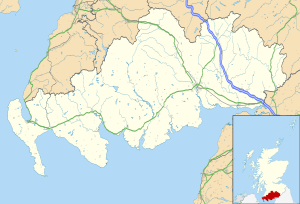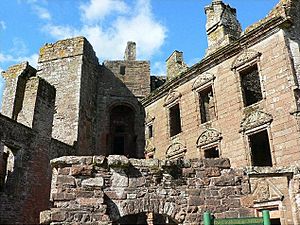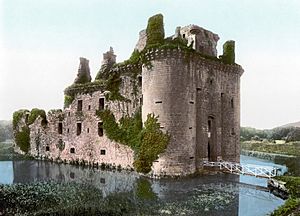Caerlaverock Castle facts for kids
Quick facts for kids Caerlaverock Castle |
|
|---|---|
| 11 km (7 mi) south of Dumfries, Dumfries and Galloway GB grid reference NY024655 in Scotland |
|
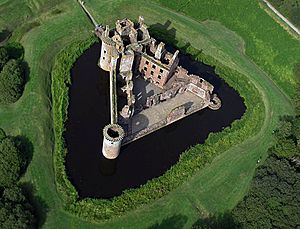
Caerlaverock Castle from the air
|
|
| Coordinates | 54°58′32″N 3°31′26″W / 54.9756408°N 3.5239534°W |
| Site information | |
| Owner | Historic Environment Scotland |
| Open to the public |
Yes |
| Condition | Partially demolished |
| Site history | |
| Built | Late 13th century |
| Built by | Clan Maxwell |
| Demolished | 1640 (partial demolition) |
| Events | Sieges in 1300 and 1640 among others |
Caerlaverock Castle is a unique castle with a triangular shape, surrounded by a moat (a deep, wide ditch filled with water). It was first built in the late 1200s. You can find it on the southern coast of Scotland, about 11 kilometers (7 miles) south of Dumfries. It sits right next to the Caerlaverock National Nature Reserve.
For about 400 years, from the 13th to the 17th century, Caerlaverock was a strong home for the Maxwell family. During the Wars of Scottish Independence, English armies attacked it. The castle was partly destroyed and rebuilt many times over the 1300s and 1400s.
In the 1600s, the Maxwells became important nobles called Earls of Nithsdale. They built a fancy new living area inside the castle walls. This new part was one of the most impressive early classical buildings in Scotland. In 1640, the castle faced its last attack from a Protestant army called the Covenanters. After this, the castle was left empty. Even though it was destroyed and rebuilt many times, Caerlaverock Castle still has its special triangular shape from when it was first built. It was originally built to control trade routes.
Today, Caerlaverock Castle is a protected historic site looked after by Historic Environment Scotland. It is a popular place for tourists to visit.
Contents
What's in a Name?
The name Caerlaverock comes from an old language spoken in Britain. The first part, "Caer," means "a protected place" or "fort." The second part might come from a person's name or an old river name that meant "talkative." The name we use today has also been shaped by the Scots word "laverock," which means "skylark" (a type of bird).
Castle History
Before the current castle, there were other forts nearby. A Roman fort once stood on Ward Law Hill, and a British hill fort was used around the year 950. Old stories from the 1100s say that a king named Gwenddoleu ap Ceidio died near here in 573. His death made his bard, Myrddin Wyllt, go mad and hide in the woods. This story later inspired the famous character of Merlin in the legends of King Arthur.
The Maxwell family, who owned Caerlaverock, can be traced back to the 1000s. John Maxwell, who lived in the 1200s, was the first Lord Maxwell of Caerlaverock. The castle and lands stayed with the Maxwell family for many generations.
The first mention of the Caerlaverock lands was around 1160. Around 1220, the King of Scotland gave the lands to Sir John Maxwell. Sir John started building the first castle at Caerlaverock. This early castle was square and made of stone, one of the first of its kind in Scotland. It had a moat and a bridge. Only its foundations remain today.
This first castle might not have been finished. It was abandoned for a new spot about 200 meters (656 feet) north. Here, Sir John's brother, Sir Aymer Maxwell, began building the castle we see today. This "new" castle was finished in the 1270s.
When the moat for the second castle was dug, the stones dug out were probably used to build the castle itself. The main entrance (gatehouse) stands on natural rock, but the rest of the castle was built on a special clay platform.
Wars for Independence
In 1299, the soldiers at Caerlaverock attacked Lochmaben Castle, which was held by English forces.
The Siege of Caerlaverock (1300)
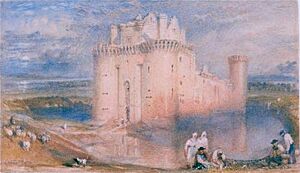
In July 1300, King Edward I of England marched north with a huge army to attack Caerlaverock. Many important English nobles and knights were with him. The Maxwells, led by Sir Eustace Maxwell, bravely defended the castle. They fought off the English many times. In the end, the small group of only sixty defenders had to give up. They had held off the entire English army for a long time.
During this siege, English heralds (officials who managed coats of arms) wrote a poem in Old French. This poem, called the Siege of Caerlaverock, named each noble and knight present. It described their brave actions and their family symbols.
Castle Changes Hands
After the siege, Sir Eustace Maxwell got the castle back. At first, he supported John Balliol, another claimant to the Scottish throne. Later, he switched his support to Robert Bruce. Because of this, the English attacked the castle again, but they failed. Sir Eustace then decided to partly destroy the castle himself. He did this to prevent the English from taking it and using it as a base. Robert Bruce rewarded him for this sacrifice.
By 1337, people were living in the castle again. Sir Eustace changed sides once more, supporting Edward Balliol. Around 1355, Sir Roger Kirkpatrick captured Caerlaverock for David II of Scotland and partly dismantled it again.
Rebuilding and New Additions
By the end of the Wars of Independence in the mid-1300s, the Maxwells had regained Caerlaverock. Sir Robert Maxwell rebuilt much of the castle between 1373 and 1410. More work was done in the mid-1400s, likely including rebuilding the gatehouse. A new building was added inside the western walls around 1500.
The Maxwells were Catholic and supported Mary, Queen of Scots, after she was forced to give up her throne in 1567. In 1570, an English Protestant army attacked Caerlaverock. The castle was partly destroyed again, and its gatehouse was blown up with gunpowder.
By 1593, John Maxwell, the 8th Lord Maxwell, was repairing the castle once more. He rebuilt the gatehouse to defend against the Johnstone family, with whom the Maxwells were fighting. The 8th Lord was killed by the Johnstones. In 1613, the 9th Lord Maxwell was executed for taking revenge on Sir James Johnstone.
The Earls of Nithsdale
In 1619, Robert Maxwell, the 10th Lord Maxwell, married Elizabeth Beaumont. She was a cousin of the Duke of Buckingham, a close friend of King James VI of Scotland. Because of this, Robert was made the Earl of Nithsdale and given an important role in the Scottish government. To show his new high status, he built the fancy south and east buildings inside the castle, known as the Nithsdale Lodging.
These new buildings were finished around 1634. The Earl of Nithsdale was at Caerlaverock in August 1637. However, religious problems soon turned against the Maxwells, who were strong Catholics. In 1640, the Protestant Covenanter army attacked Caerlaverock. They besieged it for 13 weeks, finally forcing the castle to surrender. The Earl and Countess of Nithsdale were allowed to leave, but the south wall and tower were destroyed. The castle was never repaired or lived in again after this.
In the mid-1800s, the castle was owned by William Constable-Maxwell, who was an heir of the 5th Earl of Nithsdale.
Castle Design
Caerlaverock Castle is very unusual because it has a triangular shape. It is one of only a few such castles in Europe and the only one in the UK. It is also rare for a Scottish castle to have a moat and earth mounds around it. The castle sits in a low, formerly swampy area near the River Nith. This is also unusual for a defensive building in this part of Scotland. However, it is the best example of a castle in southwest Scotland.
The castle's main shape is triangular. The main entrance, called the Gatehouse, is at the north. It has two large round towers. In the southwest and southeast corners, there are two smaller round towers. The tower in the southwest, called Murdoch’s Tower, is mostly complete. But the tower in the southeast was mostly destroyed during the Covenanter siege in 1640.
Even though the castle has been attacked and rebuilt many times, you can still see its original shape. The lower parts of the outer walls, called curtain walls, are mostly from the original building in the late 1200s. The early parts of the castle were built from red sandstone found nearby. Much of the western and eastern curtain walls still stand very tall.
Inside the castle walls, there are four main parts: the Gatehouse, the west range, the Banqueting Hall range, and the Nithsdale Lodging range. These parts were built at different times. The buildings, especially in the south, are mostly ruins. The Banqueting Hall range is only a few meters high.
- The Gatehouse range is the oldest part of the castle that remains. It has two huge round towers with the entrance passage between them. The west tower is mostly original, but the east tower was largely rebuilt in the late 1400s. The towers still stand about 15.5 meters (51 feet) high above the drawbridge. Inside, the gatehouse had a portcullis (a heavy gate that could be lowered) and a hall above.
- The west range was built around 1500. It doesn't have a roof, but it is mostly complete. This part has a series of rectangular rooms on two floors, each with a fireplace. These rooms were likely used for living.
- The south or Banqueting House range was mostly destroyed during the Covenanters' attack in 1640. The walls are only a few meters high or less. The Hall was very large, and you can still see parts of its big fireplace on the north wall.
- The Nithsdale Lodging building is in the northeast part of the castle's inside. It was the last part of the castle to be built and is the most complete. It has a beautiful Renaissance-style front from the 1630s. This front is decorated with carvings above nine large windows, three smaller ones, and two doorways. These carvings show family symbols and other designs. Inside, the rooms are quite small because of a large fireplace in the middle. The ground floor had kitchens and other service rooms, while the upper floors were likely private apartments.
Nature Around the Castle
Caerlaverock Castle is located within the Nith Estuary National Scenic Area. This area is protected for its beautiful views, and the castle is a well-known landmark. The castle is at the northern edge of the Caerlaverock National Nature Reserve. This reserve covers 55 square kilometers (21 square miles) and includes saltmarsh, mudflats, and grazing land. It is a very important place for waterfowl and wading birds that spend the winter there, including the barnacle goose.
See also
 In Spanish: Castillo de Caerlaverock para niños
In Spanish: Castillo de Caerlaverock para niños


